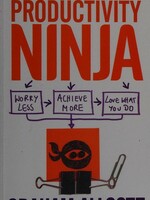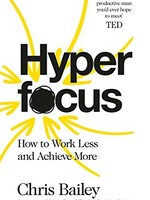Solving the Productivity Puzzle - Book Summary
How to Engage, Motivate and Develop Employees to Improve Individual and Business Performance
Release Date: April 22, 2024
Book Author: Tim Ringo
Categories: Management & Leadership, Productivity, Corporate Culture
Release Date: April 22, 2024
Book Author: Tim Ringo
Categories: Management & Leadership, Productivity, Corporate Culture
In this episode of 20 Minute Books, we delve into "Solving the Productivity Puzzle" by Tim Ringo, a vital resource that addresses the complex challenges of people management. Published in 2020, this guide explores essential themes such as employee motivation, learning and development, and strategic planning to enhance workforce productivity. It is tailored for human resources professionals keen on fostering a workplace environment where individuals can excel and thrive.
Author Tim Ringo brings to the table nearly three decades of expertise in HR consultancy and software solutions. His significant roles include serving as Vice President of SAP Success Factors for Europe, the Middle East, and Africa, and contributing as a board member and non-executive director of Optunli—a company specializing in strategic workforce planning. Known also as a seasoned conference speaker and the co-author of "Calculating Success," Ringo’s insights in "Solving the Productivity Puzzle" are grounded in rich professional experience and industry knowledge.
This book is particularly beneficial for HR managers driving change programs, leaders aiming to boost employee productivity, and individuals on the quest for the ideal job. Tune in to understand how to transform your organizational culture and significantly improve productivity at all levels.
Understanding the productivity paradox: How to align technology with human output
In the modern era, we've witnessed an astonishing progression in technology, particularly in information communications technology. Logically, one would expect such advancements to enhance human productivity significantly. Surprisingly, this hasn't been the case. Although there was a noticeable surge in productivity in the 1990s, the expected continuous increase has stagnated since 2004.
This discrepancy between technological advancement and human productivity raises a crucial question — why aren't we experiencing a golden age of productivity when we have the most advanced tools at our disposal? This productivity paradox is a puzzling scenario where despite having cutting-edge technology, the expected growth in productivity is unachieved.
In today's guide, we will explore the intricacies of this paradox, uncovering not only why this anomaly occurs but also how your organization can leverage specific strategies to navigate and overcome it. You will discover the vital concept of "PEIP" — a framework that promises to synchronize technology and manpower to fuel productivity. Additionally, we will delve into the various challenges and opportunities that lie ahead in this journey.
Finally, we'll provide insights on how to compellingly build a case for change within your organization, ensuring that stakeholders recognize the urgency and importance of addressing this paradox. By understanding and applying these strategies, you can pave the way towards sustained productivity growth, ultimately leading to greater prosperity for all involved.
Matching the right job with the right person at the perfect time
Warren Buffett, the legendary investor, famously suggested that everyone should strive for a job that makes them leap out of bed each morning with enthusiasm. He humorously queried whether sticking with a job just for its impressive resume addition is akin to "saving up sex for your old age." Buffet’s insight touches on an essential truth about workplace satisfaction and its impact on our lives.
However, for many, the reality of daily responsibilities like mortgages, school fees, and car payments can lead to staying in less fulfilling jobs. This often results in disillusionment and disappointment, leading one to wonder if finding the perfect job at the perfect time is merely a utopian dream.
But here's an enlightening thought—what if it isn't? The ancient Persian poet Rumi believed that every person is destined for a specific type of work, which he argued is a desire placed in every heart. If Rumi's vision were realized, our job markets would look dramatically different.
Imagine a system where job roles are perfectly aligned with individual skills and motivations, not randomly but at the ideal moment in a person’s career path. This concept, which the author introduces as PEIP—standing for People Engagement, Innovation, and Performance—proposes an ideal marketplace. Here, opportunities meet capabilities, and the balance of supply and demand is maintained effortlessly.
But let’s take this a step further. What if we integrate artificial intelligence and machine learning into this equation? These technologies could pinpoint career opportunities that not only fit your skills and passions but also ensure you are highly productive. This might sound like something out of a science fiction novel, yet with today's technology, it's entirely feasible.
This guide will delve deeper into the challenges that currently prevent this vision from being a reality, explore the potential of productivity and PEIP, and look at future opportunities. Additionally, you will learn how to effectively advocate for this transformative change within your own organization, helping turn this vision into reality.
Navigating through the challenges of the modern workplace
In a room full of professionals at any given conference, a surprising fact often comes to light—only about 35 to 40 percent of attendees can accurately state the number of employees in their organization. That number dwindles even further when they are asked to project the employee count, and the skills needed, 18 months into the future. This startling revelation underlines a critical issue: many are unaware of their current business landscape, let alone its forthcoming needs.
This ignorance poses a significant challenge especially when economic laws dictate that for continued economic growth, annual improvements in human productivity are necessary. Yet, for years, this growth in productivity has stalled, despite technological advancements. This ongoing dilemma is known as the productivity paradox and represents a formidable challenge within modern organizations.
The key message here is that organizations today, and in the future, are up against numerous challenges.
One immediate challenge is the rapid pace of technological change which often outstrips the ability of organizations to adapt their staffing structures and capabilities. Successful integration of new technologies necessitates accompanying structural adjustments that encompass who works, their roles, and where the work actually happens.
Moreover, there's an urgent need for new skills, ideas, and strategies as technology evolves. A 2018 ANSA study highlighted a concerning trend: 83 percent of workers do not believe their skills sufficiently match their job requirements.
Demographic shifts further complicate this scenario. The working-age population, defined as those aged 15 to 70, is on a decline. Meanwhile, individuals above 70 are increasingly joining or remaining in the workforce, whether by choice or out of financial necessity.
Employee well-being is another growing concern. A survey by Everest College pointed out that about 70 percent of U.S employees felt overwhelmed by unrealistic work expectations, contributing to 40 percent of them experiencing significant stress.
Often, these issues are exacerbated by poor workforce planning, resulting in misalignment where the wrong individuals are tasked with unsuitable roles at inopportune times. This disorganization can lead to talent shortages and high vacancy rates.
Lastly, as automation and artificial intelligence become commonplace, routine tasks previously carried out by humans are being reassigned to machines. This shift doesn't necessarily translate to fewer jobs but requires a workforce refocused on areas like customer experience instead.
While some of these challenges may be insurmountable, others provide opportunities for strategic planning and innovation. It is crucial for organizations to develop robust plans that not only mitigate these challenges but also harness them as opportunities for growth and improvement.
Decoding productivity: Beyond just getting things done
Productivity is a concept familiar in name, yet diverse in interpretation—like art, you recognize it when you encounter it. For many, productivity is defined by dictionary descriptions, but a too strict adherence to these can obscure its essence and potential.
Thus, the author presents a more expansive definition of productivity as "Getting stuff done that measurably improves the economic and human interests of organizations and society at large." This wide-angle view not only captures the essence of productivity but also underscores its impact on a larger scale.
The essence of productivity, as outlined by the author, comprises three core components: value, engagement, and innovation.
Starting with value — the true worth of productive individuals is undeniable. Reflecting back to 135 years ago, the invention of the steam engine marked a significant upturn in population growth and living standards. Today, as we stand at the cusp of new technological breakthroughs, leveraging these innovations can lead to unprecedented levels of prosperity. However, the challenge remains in mobilizing the right human resources. The strategy isn't to work harder but smarter, integrating people, knowledge, and technology more effectively to enhance real productivity.
The second vital component is engagement. A purpose-driven environment is the fertile ground where employees flourish. Engaged employees are not only more productive but also bring better quality to their work. Achieving this involves understanding what motivates your workforce. Although it may not always be possible to meet all their desires, showing a commitment to their needs can significantly boost their performance and dedication. This means fostering their autonomy, offering opportunities for mastery, and imbuing their roles with clear purpose.
Lastly, innovation stands as the third pillar of productivity. Contrary to what some might believe, innovation doesn’t just materialize within organizations—it must be cultivated. An environment that lacks inspiration will stifle creative energies. Conversely, when employees are genuinely engaged, they naturally drive innovation. This in turn fosters a vibrant workplace atmosphere that further stimulates creative output.
By understanding and nurturing these three components—value, engagement, and innovation—organizations can transcend traditional definitions of productivity and achieve remarkable growth and efficiency.
Enhancing productivity through smarter work and PEIP implementation
In the face of declining productivity, organizations are constantly seeking new strategies to enhance efficiency and maintain competitiveness. Central to this is the cultivation of innovative thinking and a workforce that is both engaged and innovative.
The central idea here is simple: To achieve better results, work smarter and implement PEIP (People Engagement, Innovation, and Performance).
Firstly, consider the principle of working smarter, not harder. Evidence suggests that cognitive productivity peaks at about four hours of focused work per day, yet the average American workweek spans 47 hours. Experiments with shorter workdays and weeks have not only boosted productivity but also reduced absenteeism, demonstrating that less can indeed be more.
Taking a step further, by adopting an integrated human capital lifecycle, organizations can ensure a seamless employee experience and optimize their talent placement. This approach involves strategically placing the right people in the right jobs, as opposed to merely filling positions with whoever is available. This practice not only enhances plan execution but also significantly boosts engagement, retention, and attraction of top talent.
Thirdly, implementing PEIP is crucial. The disturbing trend highlighted by a 2017 PricewaterhouseCoopers survey shows that 77 percent of CEOs view the scarcity of key skills as a major threat to their business. PEIP addresses this by ensuring that organizations have the right people with the necessary skills, at the right time and place.
Identifying who these 'right people' are depends greatly on the specific needs and culture of the organization, as well as the roles that need filling.
Furthermore, the importance of matching job roles with the requisite skills cannot be overstated. For instance, in August 2018, there were 7.14 million job vacancies in the U.S., predominantly due to skill shortages.
Also, strategic workforce planning (SWP) is vital. This involves a deep understanding of your current workforce capabilities versus future needs, and bridging any gaps effectively.
Lastly, a fundamental aspect of PEIP is fostering motivation. Creating a workplace where both employer and employee objectives align can significantly enhance job satisfaction and productivity.
When PEIP is proficiently implemented, it not only addresses existing challenges but also turns potential obstacles into opportunities for growth. In the subsequent sections, we will explore how this strategic framework aids in transforming organizational challenges into stepping stones for success.
Five transformative trends shaping the future of work
We are amidst a revolution driven by science, technology, and research that is fundamentally transforming how we live and work. From the groundbreaking potentials of quantum mechanics to the medical miracles promised by genomics, the pace of innovation is relentless. Yet, what does this mean for the workplace? How are these scientific advances translating into business innovation?
The key message here is straightforward: Five significant trends have the potential to turbocharge the future of the workplace.
Firstly, longevity is changing workforce demographics. As health advancements extend lifespans, the Organisation for Economic Cooperation and Development predicts that by 2050, nearly 10 percent of the population will be over 90 years old. Yet, many organizations are unprepared for this shift and haven't fully considered the implications of hiring and training older employees. There's a vast reservoir of talent among older generations that remains largely untapped.
Secondly, gender dynamics in the workplace are evolving. Research, including a study by Sodexo examining 50,000 managers, reveals that gender-balanced teams excel in productivity and innovation. Furthermore, organizations with a balanced workforce tend to attract more skilled individuals. This shift isn’t just about equality; it’s a strategic advantage that drives better business outcomes.
Thirdly, the potential of neurodiverse talent, particularly individuals with Autism Spectrum Disorder (ASD), is becoming more recognized. Contrary to stereotypes, many with ASD have unique skills—such as high levels of focus and detail orientation—that can significantly enhance innovation and productivity in the workplace.
Fourthly, the advent of automation signals both challenge and opportunity. While some jobs may be lost to machines, history suggests that technological disruptions often lead to better, higher-paying roles. The key lies in how effectively we integrate human and machine capabilities, leveraging each for their strengths.
Finally, the digital transformation of the workplace has lagged behind domestic advancements. Numerous homes today are equipped with cutting-edge digital devices, yet many offices remain stuck in paradigms that are decades old. However, this is beginning to change as workplaces start to embrace digital innovations.
Together, these five trends not only forecast changes but also outline opportunities for organizations to adapt and thrive in an evolving world. By understanding and leveraging these trends, businesses can position themselves at the forefront of innovation and productivity in the 21st century.
Building a compelling case for change through a structured document
Introducing a new framework like PEIP into an organization isn't just about implementing new processes; it involves convincing decision-makers of its merits. They will have numerous questions: What changes are being proposed, why now, what are the expected outcomes, and what are the potential benefits, both tangible and intangible? They'll also need a clear understanding of the associated risks, the systematic plan for implementation, and the financial implications—including the cost of inaction.
The essential task, therefore, is to create a formal document that addresses these concerns and makes a strong case for change.
Commence your document by focusing on the human element. It's important to delineate what the workforce stands to gain from PEIP because their acceptance and buy-in are crucial for successful implementation. Address concerns and illustrate how the initiative will benefit them personally and professionally.
Next, pivot to the technology aspect, detailing how these tools will be integrated into daily operations and how they can drive efficiency. It's also vital to present a clear analysis of the economic benefits: a forecast of return on investment, cost savings, and productivity enhancements.
Discuss the myriad benefits of adopting PEIP, such as simplification of processes, modernization of practices, enhanced decision-making capabilities through access to real-time data, and improvements in employee engagement and overall experience. A notable point to include is how management will gain a comprehensive overview of workforce metrics.
Furthermore, your document should provide a clear change roadmap. Start with a concise and straightforward vision statement on the first page that resonates with everyone in the organization. Set specific, measurable goals that are focused rather than broad, and highlight only the critical goals—those whose failure to achieve would significantly detriment the initiative.
Outline the strategies for accomplishing these goals, including financial and customer-centered strategies, necessary internal processes, and learning and growth initiatives to support execution. For each strategy, detail the required actions, responsible parties, timelines, and potential risks along with their mitigation plans.
Lastly, incorporate milestones into your roadmap. These allow for progress tracking and can serve as celebratory markers, providing opportunities to recognize and commend the team for their efforts and achievements.
Creating this document not only helps in making your case for implementing PEIP but also serves as a blueprint guiding the organization through the transition, ensuring alignment and readiness for the changes ahead.
Embracing the PEIP work revolution: A role for everyone
Humans are not mere cogs in a machine, driven solely by simplistic incentives like carrots and sticks. Such a model not only underestimates human potential but sets an exceptionally low bar for what workplaces could achieve. Instead, the aim should be to spark a workplace revolution—transforming jobs into roles that create engagement and fulfillment rather than mere drudgery. As the author articulates, this change isn’t just about altering workplace dynamics; it's about reshaping our society and how we live within it.
The endeavor to achieve this change poses its challenges, yet there exists a clear path forward—one that requires the participation of everyone.
The key message is clear: Everyone has a vital role in the PEIP work revolution.
Globally, small-to-medium-sized enterprises (SMEs), which make up the majority of global employment, are poised to be the champions of change. With fewer entrenched systems and legacy issues compared to larger corporations, SMEs are naturally more agile and can integrate PEIP principles more swiftly.
In the public sector, the challenges are unique. The primary focus here is not just on enhancing productivity and service delivery but also on utilizing taxpayer money judiciously. Despite high service demands leading to low employee engagement, the public sector is driven by a noble purpose—many are motivated by the mission to serve. The implementation of PEIP here will likely hinge on political determination and will.
The private sector stands to benefit immensely from PEIP. For successful integration, it must concentrate on five crucial actions: deeply understanding its workforce, planning and executing change programs effectively, engaging stakeholders including workforce, customers, and suppliers, investing in personnel development, and tracking improvements in staff performance meticulously.
But the call for action isn’t limited to organizations; individuals too must actively participate. Leaders should define and drive the next steps for business evolution. Human Resources professionals ought to embrace and own the strategic direction, fostering an environment where engagement and innovation are the benchmarks of productivity. Employees should adopt a proactive stance—taking control of their own career paths and contributing positively to the PEIP framework.
The renowned writer Ernest Hemingway famously said, “Don’t mistake motion for action." This sentiment resonates deeply with the need for meaningful participation in the PEIP revolution. It's time to engage actively, innovate purposefully, and perform optimally. Each of us holds a piece of the puzzle; together, we can create workplaces—and consequently, a society—that thrives on prosperity and happiness.
Concluding insights on the path to enhanced productivity
The core takeaway from our discussion is unmistakably clear:
PEIP—aligning the right people with the right skills, at the right place and time, powered by the right motivation—is fundamental for unraveling and solving the productivity puzzle. Establishing a compelling business case for PEIP implementation involves setting distinct, measurable goals and milestones, and outlining clear objectives. This strategic framework not only serves to enhance productivity within an organization but also propels a broader workplace revolution.
This transformation demands participation from everyone, from top management to front-line employees. Each individual has a unique role to contribute to this evolution, ensuring that the entire organization moves in unison towards more engaged, innovative, and highly productive operations.
By embracing this approach, organizations can indeed solve the productivity paradox and set themselves on a path of sustainable growth and continual improvement.






